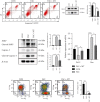Melatonin Repairs Osteoporotic Bone Defects in Iron-Overloaded Rats through PI3K/AKT/GSK-3 β/P70S6k Signaling Pathway
- PMID: 36703914
- PMCID: PMC9873465
- DOI: 10.1155/2023/7718155
Melatonin Repairs Osteoporotic Bone Defects in Iron-Overloaded Rats through PI3K/AKT/GSK-3 β/P70S6k Signaling Pathway
Abstract
It was found recently that iron overload can cause osteoporosis in rats. Through in vitro and in vivo experimentations, the purpose of the present study was to validate and confirm the inhibitory effects of melatonin on iron death of osteoporosis and its role in bone microstructure improvements. Melatonin (100 mol/L) was administered to MC3T3-E1 cells induced by iron overload in vitro for 48 hours. The expression of cleaved caspase-3 and cleaved PARP and the production of ROS (reactive oxygen species) and mitochondrial damage were all exacerbated by iron overload. On the other hand, melatonin restored these impacts in MC3T3-E1 cells produced by iron overload. By evaluating the expression of PI3K/AKT/GSK-3β/P70S6k signaling pathway-related proteins (RUNX2, BMP2, ALP, and OCN) using RT-PCR and Western blot, osteogenic-related proteins were identified. Alizarin red S and alkaline phosphatase were utilized to evaluate the osteogenic potential of MC3T3-E1 cells. Melatonin significantly improved the osteogenic ability and phosphorylation rates of PI3K, AKT, GSK-3β, and P70S6k in iron overload-induced MC3T3-E1 cells. In vivo, melatonin treated iron overload-induced osteoporotic bone defect in rats. Rat skeletal microstructure was observed using micro-CT and bone tissue pathological section staining. ELISA was utilized to identify OCN, PINP, CTX-I, and SI in the serum of rats. We discovered that melatonin increased bone trabecular regeneration and repair in osteoporotic bone defects caused by iron overload. In conclusion, melatonin enhanced the osteogenic ability of iron overload-induced MC3T3-E1 cells by activating the PI3K/AKT/GSK-3β/P70S6k signaling pathway and promoting the healing of iron overload-induced osteoporotic bone defects in rats.
Copyright © 2023 Maoxian Ren et al.
Conflict of interest statement
The authors declare that they have no conflicts of interest.
Figures







References
-
- Adachi J. D., Ioannidis G., Pickard L., et al. The association between osteoporotic fractures and health-related quality of life as measured by the health utilities index in the Canadian multicentre osteoporosis study (CaMos) Osteoporosis International . 2003;14(11):895–904. doi: 10.1007/s00198-003-1483-3. - DOI - PubMed
MeSH terms
Substances
LinkOut - more resources
Full Text Sources
Medical
Research Materials

